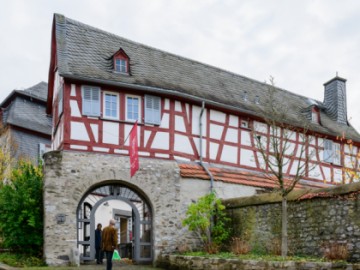Limburg Cathedral: history of a double church
Limburg Cathedral resembles a fairy tale castlebecause of its unusual colors and seven towers of different heights. It islocated on a hill overlooking the river. Before Germany moved to the settlementin Euro, the image of the cathedral adorned a thousand-mark note. Built in theXIII century, the temple is still in excellent condition and is one of the mostsignificant samples of the late Romanesque architecture.
The unusuallocation of the Limburg Cathedral - on the edge of the old town and not in thecenter as is usually the case – owes to the fact that its predecessor was a chapeldedicated to St. George. The castle itself was built in the Merovingian period(VIII century or a bit earlier), and the chapel appeared in the early IX century.In 910, count Konrad Kurzbold, who was granted the castle, founded a communityof 18 canons on the hill. The castle chapel was demolished and a three-nave basilicawas built in its place and served for several centuries.
The constructionof the current building started around 1190. The new church, named a CollegiateChurch of St. George and St. Nicholas, was built mainly at the expense ofwealthy merchants, who made a fortune due to crusades. The fact that the churchwas dedicated to two saints at once, can be attributed to its dual purpose. Itserved as a parish church for both Limburg citizens, whose patron saint wasSaint Nicholas, and a collegiate church for the canons patronized by SaintGeorge. All the saints had their altars, their priests and circle of churchmembers.
Until 1600, thefuture Limburg Cathedral was divided into two parts by a special partition.After secularization in 1803, the monastery was dissolved and its property was transferredinto ownership of the Duchy of Nassau. In 1827, a new Catholic bishopric wascreated in its territory with the center in Limburg, due to which the church ofSt. George has received the status of a cathedral, which is preserved to thisday.
In the XX century,the facade of the Limburg Cathedral was re-painted since the exterior wallswere earlier cleaned of plaster and paint. But later it turned out that stonemasonry in the open form destroyed faster. Since then the walls of thecathedral have been painted bright orange, white and yellow. Inside thecathedral worth paying attention are the luxury murals, some of which date backto the XIII century. The tomb of Count Konrad Kurzbold in the north transepttakes pride of place. Sculptures at the bottom depict four canons being inprayer, a bear and a lion (the latter ones represent the strength and courageof the deceased).






































